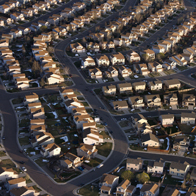Bicycle City Influences
Bicycle City doesn’t exist in a vacuum. Our influences include:
- Paolo Soleri
- Jane Jacobs
- Frank Lloyd Wright
- John Robbins
- Scott Martin
- John Naisbitt
- Richard Register
- Andres Duany
- Elizabeth Plater-Zyberk
- Maria Montessori
- Jane Goodall
We have also been influenced by the many places we have visited, including:
- Amsterdam, Netherlands
- Arcosanti, Arizona
- Catalina Island, California
- Hydra Island, Greece
- Mackinac Island, Michigan
- Zermatt, Switzerland
Paolo Soleri
Born in 1919 in Turin, Italy, Soleri founded the Arcosanti community in 1970 north of Phoenix, Arizona. Soleri studied architecture at Politecnico di Torino and studied in fellowship with Frank Lloyd Wright. He is a noted ceramic artist and author, and he is also a lecturer at the Arizona State University College of Architecture.
Jane Jacobs
An urban activist, Jacobs is known for her 1961 book, The Death and Life of Great American Cities, which offers a critique of American urban renewal policy. As an activist, Jacobs has been responsible for blocking projects which she felt would destroy neighborhoods. Jacobs died in 2006, and in 2007, the Rockefeller Foundation announced the Jane Jacobs Medal, awarded to those who make significant contributions to urban design.
Frank Lloyd Wright
Wright was a champion for organic architecture, that which is built to exist in unison with its surroundings. A designer of more than 500 completed projects, Wright is well-known for buildings such as Fallingwater, the Robie House and the Guggenheim Museum. Wright passed away in 1959, but was honored in 1991 as the greatest American architect of all time by the American Institute of Architects.
John Robbins
Robbins founded the organization EarthSave, which promotes food choices that avoid animal cruelty and are environmentally-sound. Robbins has written extensively about the connections agriculture and environment have on health.
Scott Martin
In 1992, Martin authored the article Cycle City 2000 for Bicycling magazine. Its publication helped to solidify our early ideas for Bicycle City, which were presented during the spring of 1992 to the American Graduate School of International Management – Thunderbird. Cycle City 2000 offers a dream-like future scenario, taking the reader 8 years ahead to the year 2000 and asks them to imagine commuting to work on a bicycle via a tube system that helps propel each bicycle to regular highway speeds with minimal effort.
John Naisbitt
Naisbitt wrote High-Tech, High-Touch: Technology and Our Search for Meaning in 1999, a book that has greatly influenced our goals for the Bicycle City communities. He discusses how increasing technology (high-tech) is decreasing human contact and ideals of community (high-touch), and seeks to strike a balance between the two, using the great benefits of technology to provide a greater sense of self and community.
Richard Register
The founder and president of Ecocity Builders and founding president of Urban Ecology, Register is a world-renowned speaker, theorist and author on ecological planning and design. He has authored three books on ecocity planning and has spoken at four United Nations’ environmental conferences. Register is also a Bicycle City advisor.
Andrès Duany and Elizabeth Plater-Zyberk
In 1980, the husband-and-wife team founded Duany Plater Zyberk & Company in 1980 in Miami, Florida, and quickly became a national leader in the movement of new urbanism. DPZ has designed more than 300 new and existing communities. Duany also helped to co-found Congress for the New Urbanism and has helped write two books on urban planning. Bicycle City is being planned to utilize many New Urbanist principles.
Maria Montessori
Montessori is known for developing the Montessori method of education, which is used today in public and private schools around the world. Montessori believed that children learn spontaneously, and fostered this approach in her first school in 1907. She also believed that children are best taught in three-year age groups and in environments that are self-directed, that allow them to make decisions and that are both stimulating and motivating.
Jane Goodall
Goodall is famous for her extensive work with chimpanzees, and she is also a committed environmentalist, working to protect tropical forests and chimpanzee habitats. As an animal activist, she is the former president of Advocates for Animals.
Amsterdam, Netherlands
Amsterdam is considered the bicycle capital of the world for its heavy ridership and incredible city commitment to cycling. The city is home to a bicycle garage that can park 10,000 bikes, making it easier for the 40% of Amsterdam residents who commute to work via bicycle.
Arcosanti, Arizona
Arcosanti was born out of Soleri’s principle of arcology, which is architecture existing in harmony with ecology. Located about 70 miles north of Phoenix, Arizona, Arcosanti considers itself to be an alternative to urban sprawl, as well as an urban laboratory for future design. When completed, Arcosanti will be home to 5,000 people and its buildings will occupy just 25 acres of its 4,060 acre preserve.
Catalina Island, California
Catalina Island is found 22 miles from the coast of Long Beach and is home to nearly 4,000 residents. Most of the island is car-free and most travel via golf cart, though some residents own cars with special permits.
Hydra Island, Greece
Hydra Island has no modern development—no land traffic, no industrial pollution, and no large concrete buildings. Hydra Island boasts about its safety, peace and quiet, unique 18th century architecture, plethora of cafes, and sense of freedom.
Mackinac Island, Michigan
Motor vehicles are prohibited from this resort island in Northern Michigan and most travel is done on foot or by carriage. The island is approximately four square miles in size and is an extremely popular summer destination for vacationers.
Zermatt, Switzerland
Zermatt is a car-free resort town that only allows electric-powered cars, bikes, and horse- and sleigh-drawn carriages on its roads. The streets are reserved for residents and visitors to shop, dine, and enjoy the town without traffic safety concerns.

 Our lifestyles are polluting the earth as at rate that cannot continue unchecked.
Our lifestyles are polluting the earth as at rate that cannot continue unchecked.
 In the United States, obesity and physical inactivity are shortening life spans and are listed among the leading causes of preventable death. The design of our cities and communities, which focuses more on cars than on people, often precludes the opportunity to get exercise by walking or biking from home to school, work, shopping, etc. In just one generation, the number of children who walk to school has declined by 70%. During that time childhood obesity has tripled. (Source:
In the United States, obesity and physical inactivity are shortening life spans and are listed among the leading causes of preventable death. The design of our cities and communities, which focuses more on cars than on people, often precludes the opportunity to get exercise by walking or biking from home to school, work, shopping, etc. In just one generation, the number of children who walk to school has declined by 70%. During that time childhood obesity has tripled. (Source: 